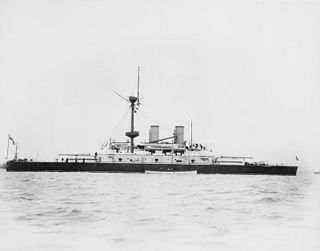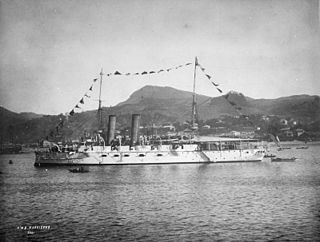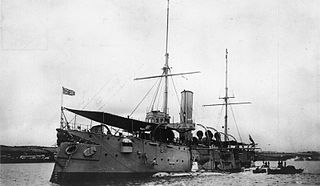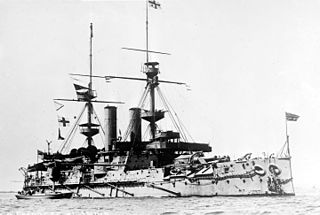
HMS Australia was one of seven Orlando-class armoured cruisers built for the Royal Navy in the mid-1880s. She was assigned to the Mediterranean Fleet in 1889 and remained there until 1893 when she returned home. The ship was assigned to the Coast Guard Squadron for the next decade before she was placed in reserve in 1903. Australia was sold for scrap in 1905.

HMS Galatea was one of seven Orlando-class armoured cruisers built for the Royal Navy in the mid-1880s. She was sold for scrap on 5 April 1905.

HMS Howe was an Admiral-class ironclad battleship built for the Royal Navy during the 1880s. The ship was assigned to the Channel Fleet in mid-1890 and was badly damaged when she ran aground in late 1892. After repairs were completed, Howe was transferred to the Mediterranean Fleet in late 1893. She returned home in late 1896 and became a guardship in Ireland. Howe remained there until late 1901 when she was assigned to the Reserve Fleet. The ship was paid off in three years later and then sold for scrap in 1910.

HMS Anson was the last of six Admiral-class ironclad battleships built for the Royal Navy during the 1880s. The ship was completed, except for her armament, in 1887, but had to wait two years for her guns to be installed. She was assigned to the Channel Fleet in mid-1889 as a flagship for the fleet's second-in-command. Two years later, the passenger ship SS Utopia sank with the loss of 562 lives after colliding with Anson in the Bay of Gibraltar. In mid-1893, Anson was transferred to the Mediterranean Fleet, subsequently returning home in 1900 when she was assigned to the Reserve Fleet. She recommissioned for the Home Fleet in early 1901. Anson was paid off three years later and then sold for scrap in 1909.

HMS Hogue was a Cressy-class armoured cruiser built for the Royal Navy around 1900. Upon completion she was assigned to the Channel Fleet and the China Station. In 1906 she became a training ship for the North America and West Indies Station before being placed in reserve in 1908. Recommissioned at the start of World War I, she played a minor role in the Battle of Heligoland Bight a few weeks after the beginning of the war. Hogue was sunk by the German submarine U-9, together with two of her sister ships, on 22 September 1914.

HMS Sutlej was a Cressy-class armoured cruiser built for the Royal Navy around 1900. Upon completion she was assigned to the China Station. In 1906 she became a training ship for the North America and West Indies Station before returning home and being assigned as the flagship of the reserve Third Fleet in 1909. Relieved as flagship in 1910, she remained in reserve until the beginning of World War I in August 1914.

HMS King Alfred was one of four Drake-class armoured cruisers built for the Royal Navy around 1900. She served as flagship of the China Station from 1906 until relieved in 1910. Upon her return home that year, she was placed in reserve before being recommissioned in mid-1914. She was assigned to the 6th Cruiser Squadron of the Grand Fleet at the beginning of World War I. She was transferred to the 9th Cruiser Squadron in 1915 and assigned to convoy protection duties by the end of the year. King Alfred participated in the unsuccessful searches for the German commerce raider SMS Möwe in 1916–17 before beginning to escort convoys later that year. The ship was torpedoed by a German submarine in 1918, but returned to service. She was sold for scrap in 1920.

HMS Leviathan was one of four Drake-class armoured cruisers built for the Royal Navy around 1900. She was assigned to the China Station upon completion and then served in the Mediterranean Fleet in 1905–06. She was assigned to the 7th Cruiser Squadron in 1907 before she was briefly reduced to reserve. Leviathan was recommissioned in 1909 for service with the 4th Cruiser Squadron before she was placed in reserve in 1913.

HMS Essex was one of 10 Monmouth-class armoured cruisers built for the Royal Navy in the first decade of the 20th century. Upon completion in 1904 she was assigned to the 2nd Cruiser Squadron of the Channel Fleet. The ship was placed in reserve in March 1906 and recommissioned in 1909 for service with the 4th Cruiser Squadron on the North America and West Indies Station. In 1912, Essex returned home and was assigned to the Training Squadron of the Home Fleet. After a refit the following year, she rejoined the 4th Cruiser Squadron in early 1914.

HMS Devonshire was the lead ship of her class of six armoured cruiser built for the Royal Navy in the first decade of the 20th century. She was assigned to the 1st Cruiser Squadron of the Channel Fleet upon completion in 1905 and was transferred to the 2nd Cruiser Squadron of the Atlantic Fleet in 1907. She was assigned to the reserve Third Fleet in 1909 and then to the 3rd Cruiser Squadron of the reserve Second Fleet in 1913.

HMS Andromeda was one of eight Diadem-class protected cruisers built for the Royal Navy in the 1890s. Upon completion in 1899, the ship was assigned to the Mediterranean Fleet where she helped to escort a royal yacht during its cruise through the Mediterranean Sea. After a refit, she was assigned to the China Station in 1904 and returned home three years later to be reduced to reserve. Andromeda was converted into a training ship in 1913 and remained in that role under various names until 1956. That year she was sold for scrap and broken up in Belgium, the last Pembroke-built ship still afloat.

HMS Undaunted was one of seven Orlando-class armoured cruisers built for the Royal Navy in the mid-1880s.

HMS Narcissus was one of seven Orlando-class armoured cruisers built for the Royal Navy in the mid-1880s. Future Admiral Ernest Gaunt served aboard her in 1896 as First Lieutenant. She was sold for scrapping on 11 September 1906.

HMS Immortalité was one of seven Orlando-class armoured cruisers built for the Royal Navy in the mid-1880s. She was sold for scrap on 11 January 1907.

HMS Thames was a Mersey-class protected cruiser built for the Royal Navy (RN) in the 1880s. The ship was placed in reserve upon her completion in 1888 and was converted into a submarine depot ship in 1903. She was sold out of the navy in 1920 and was purchased by a South African businessman to serve as a training ship for naval cadets under the name SATS General Botha. The ship arrived in South Africa in 1921 and began training her first class of cadets in Simon's Town the following year. General Botha continued to train cadets for the first several years of World War II, but the RN took over the ship in 1942 for use as an accommodation ship under her original name. She was scuttled by gunfire in 1947 and is now a diveable wreck.

HMS Empress of India was one of seven Royal Sovereign-class pre-dreadnought battleships built for the Royal Navy during the 1890s. The ship was commissioned in 1893 and served as the flagship of the second-in-command of the Channel Fleet for two years. She was transferred to the Mediterranean Fleet in 1897, during which time Empress of India was assigned to the International Squadron blockading Crete during the uprising there. She returned home in 1901 and was briefly assigned as a coast guard ship in Ireland before she became the second flagship of the Home Fleet. The ship was reduced to reserve in 1905 and accidentally collided with the submarine HMS A10 the following year. Empress of India was taken out of service in early 1912 and accidentally struck a German sailing ship while under tow. She was sunk as a target ship in 1913.

HMS Royal Oak was one of seven Royal Sovereign-class pre-dreadnought battleships built for the Royal Navy during the 1890s. Upon her completion in 1894, she was initially placed in reserve until mobilised in 1896 for service with the Flying Squadron. After returning briefly to reserve, the ship was assigned the following year to the Mediterranean Fleet. Royal Oak remained there until 1902 when she returned home; after a refit, the ship was assigned to the Home Fleet, where she served as the flagship of the fleet's second-in-command in 1904–05. Royal Oak was then reduced to reserve until she was taken out of service in 1911. The ship was sold for scrap in early 1914.

HMS Renown was a second-class predreadnought battleship built for the Royal Navy in the early 1890s. Intended to command cruiser squadrons operating on foreign stations, the ship served as the flagship of the North America and West Indies Station and the Mediterranean Fleet early in her career. Becoming obsolete as cruiser speeds increased, Renown became a royal yacht and had all of her secondary armament removed to make her more suitable for such duties. She became a stoker's training ship in 1909 and was listed for disposal in 1913. The ship was sold for scrap in early 1914.

HMS Sentinel was one of two Sentinel-class scout cruisers built for the Royal Navy in the first decade of the 20th century. The ship was initially assigned to the Mediterranean Fleet before returning home and being reduced to reserve in 1907. Recommissioned two years later as part of the Home Fleet, she spent the next five years moving on and off of active service in British waters. Sentinel was assigned to coastal defence duties when the First World War began in 1914, although she was transferred to the Mediterranean in 1915. By 1918 the ship had been assigned to the Aegean. After the end of the war in November, Sentinel was sent to the Black Sea as the British attempted to intervene in the Russian Civil War. The ship returned home in early 1919 and was paid off. She became a training ship from mid-1920 to the end of 1922 and was sold for scrap in early 1923.
HMS Skate was a Sturgeon-class destroyer which served with the Royal Navy. Built by Vickers, she was launched on 13 March 1895 and sold on 9 April 1907.




















